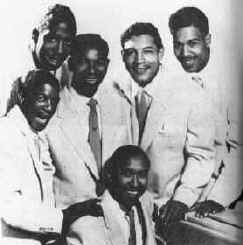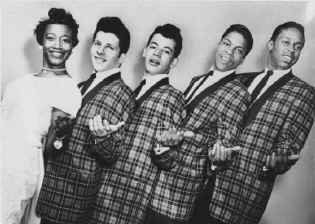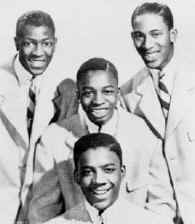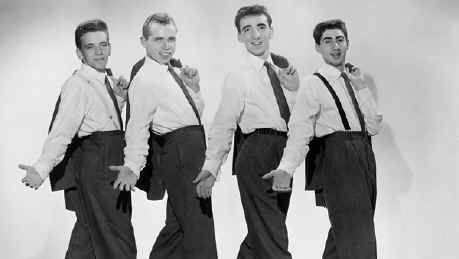
Top from left: William Edwards, Carl Feaster, Jimmy Ketes, Buddy McRae
Far left: Claude Feaster
Bottom center: Rupert Branker
The Chords got together in the mid-fifties and sang at small social functions.
Chords

Top from left: William Edwards, Carl Feaster,
Jimmy Ketes, Buddy McRae
Far left: Claude Feaster
Bottom center: Rupert Branker
The Chords got together in the mid-fifties and sang at
small social functions.
Members:
Carl Feaster - lead
Claude Feaster - baritone
James Keyes - first tenor
Floyd (Buddy) McRae - second tenor
replaced by Arthur Dix
William Edwards - bass replaced by Joe
"Ditto" Dios
The Chords- Carl and Claude Feaster (lead and baritone), Jimmy Keyes (first tenor), Floyd "Buddy" McRae (second tenor), and Ricky Edwards (bass) --- formed in 1951 in the Bronx, but weren't discovered until three years later, when they were spotted singing in a subway station, a performance that ultimately landed them a recording contract with Atlantic Records.
Jerry Wexler, Atlantic's top talent A&R man, had the Chords cover a Patti Page hit, "Cross Over the Bridge" (it was also covered by the Flamingos for Chance), but it was the B-side, "Sh-Boom," a swinging R&B vocal tune with a catchy intro made up of seemingly nonsensical syllables ("shh-boom, shh-boom, yadda da da yadda da da da da da") that caused considerably more commotion.
"Sh-Boom" is supposed to have been
titled after the threat of an atom bomb explosion -- Shhhh-BOOM!
-- which, in the midst of Cold War posturing in 1954, was a very
real topic on the public's collective consciousness. However,
this demented ditty also included the surreally optimistic
message that everything was ultimately fine and as the rest of
the lyrics suggested, "life could be a dream." By the
end of June 1954, "Sh-boom" had climbed up the charts
nationwide, charting on both the R&B (number five) and pop
(number two) lists, a nearly unprecedented feat for its time. For
all practical purposes -- along with the Crows' 1953 hit
"Gee" (another upbeat B-side hit that DJs flipped over)
-- "Sh-Boom" introduced the white audience to black
R&B music for the first time.
Not everyone thought the song was a precursor of good things to
come. Peter Potter, host of TV's popular "Juke Box
Jury," was seemingly aghast at the state of this then-new
trend in pop music and attacked "Sh-Boom" asking if
anyone would remember the admittedly demented ditty in five, let
alone 20 years time and whether any record label would even think
to re-release it in the future. The answers to his rhetorical
questions were, of course, yes and yes.
The songwriters were deluged by music publishing companies
wanting to buy the rights to "Sh-Boom" in order to reap
huge potential earnings (the group quickly came to an agreement
with Hill & Range). Soon there were cover versions hitting
radio stations across the country simultaneously with the Chords'
original single. Some were memorable and some otherwise,including
a countrified take by the Billy Williams Quartet for Coral, and
-- more notably -- the Crew Cuts' version for Mercury.
The Chords soon appeared on TV shows (still an invention not yet
in many U.S. homes), but were knocked for a loop when they
learned there was a more-obscure group already using the name
Chords. They were forced to change their name to the Chordcats.
Subsequent Atlantic record ads noted that their group was the
creators and originators of "Sh-Boom," even though the
Canadian Crew Cuts' paler pop version by then had knocked the
Chords' R&B-styled version off the charts.
Atlantic later moved the Chords over to their new Cat Records
subsidiary, releasing numerous additional singles which mostly
failed to chart. A last gasp attempt to resurrect the act came in
mid-1955 when the group renamed themselves the Sh-Booms after
their one big hit. The Chords/Chordcats/Sh-Booms went through
several personnel changes during the late '50s, recording a
handful of forgettable records for Vik Records in 1957, and
eventually returned to Atlantic in 1960 for one last recording
before slipping away into the ether of time. -- Bryan Thomas
The Chords were inducted into the Vocal Group Hall of Fame in 2007
Carl Feaster died January 10, 1981 at the age of
50.
Claude Feater died November 1978 at the age of 45
Jimmy Keyes died July 22 ,1995 at the age of 65.
Floyd McRae died March 19, 2013 in a nursing home in the Bronx at
the age of 85.
William Edwards died 1964.
|
|
|
Members:
Herb Cox - lead
Berman Patterson - second tenor
Warren Corbin - bass
Charles James - first tenor
William McClane - baritone - replaced
by Gene Peterson 1959
Patrica Spann
Formed in Queens, NY, in 1955, the Cleftones consisted of five friends from Jamaica High School -- Herb Cox (lead), Warren Corbin (bass), Charlie James (first tenor), William McClain (baritone), and Berman Patterson (second tenor). Originally signed to Gee, the group released its first single, "You Baby You," late in 1955; an up-tempo doo wop song, the record became a regional hit. "Little Girl of Mine," the Cleftones' second single, broke nationally, charting at number eight R&B and number 57 pop in 1956; two other similar singles, "Can't We Be Sweethearts" and "String Around My Heart," were released the same year, yet they failed to attract national attention. "See You Next Year," a ballad the group recorded in 1957, did not earn the group an audience outside of New York. Two years later, McClain left the group and was replaced by Gene Pearson from the Rivileers. Patricia Spann was also added to the Cleftones' lineup that year, which helped nudge the band away from traditional group-oriented doo wop harmonies and towards a vocal sound that was dominated by the lead vocals. In 1961, the Cleftones realized the potential of the sound with their smash hit version of the standard "Heart and Soul;" it became the group's biggest hit, reaching number 18 on both pop and R&B charts. Later that year, the group had another hit with "For Sentimental Reasons," but the band had reached a peak with "Heart and Soul" and were never able to reach those heights again. The Cleftones broke up in 1964, three years after their greatest success. ~ Stephen Thomas Erlewine, All-Music Guide
Herb Cox died in Fayetteville, Georgia on December 7, 2019 at the age of 81.
Corsairs

Top Row: James Uzell, Jay Uzell
Bottom Row: George Wooten, Moses Uzell
Another fine North Carolina rhythm and blues group, the Corsairs
were three brothers and a cousin.
Members:
Jay Uzzell - lead
James Uzzell
Moses Uzzell
George Wooten
Artist Biography by Andrew Hamilton
The Corsairs originated from La Grange, NC, releasing seven records as the Corsairs, and one as Landy McNeil & the Corsairs, the first on Smash, and the rest on Tuff Records. Their lineup consisted of three brothers, Jay, James, and Moses Uzell, and cousin George Wooten. As the Gleems they sang at all the local functions and made their way north to the New Jersey/New York area, and were discovered harmonizing in a Newark, NJ, night spot by Abner Spector. Spector later hit with "Sally Go Round the Roses" by the Jaynettes. The family affair debuted on Smash as the Corsairs with "Time Waits" b/w "It Won't Be A Sin" in 1961, but it went unnoticed. For their second release Spector switch them to Tuff Records where they scored with "Smokey Places," which nearly cracked the pop Top Ten, settling at number 12 in 1961. Chess Records distributed this and their subsequent Tuff recordings. They followed with "I'll Take You Home" b/w "Sittin' on Your Doorstep" in 1962, a fine recording that stalled at number 62. They kept releasing singles until 1964, but "Dancing Shadows," "At the Stroke of Midnight," "Stormy (It's Almost)," and "Save a Little Monkey" did next to nothing. A versatile group, all three brothers sang lead, their recordings bridged the gap between '50s doo wop and '60s R&B. They released their final recording in 1964, "The Change in You," b/w "On the Spanish Side," as Landy McNeil & the Corsairs, but the sound had stagnated and didn't stand a chance against current favs' like "My Girl," "Baby I Need Your Loving," and other mid-'60s sounds.
Jay Uzzell died February 1, 2009.
Moses Uzzell died May 11, 2013 at the age of 80.
James Uzzell died September 10, 2014 at the age of 76.
Crest

Patricia Van Dross, Johnny
Maestro, Harold Torres, Talmadge Gough & J.T. Carter
One of the most popular of the late 50s groups, the
Crests were often thought to be and all black group. Nothing
could have been further from the truth. The group consisted of
four men (two black, a Puerto Rican and Italian) and a black
woman
| Members - Joyce Records Johnny Maestro (real name Mastrangelo) - lead Talmadge Gough - first tenor Harold Torres - baritone J.T. Carter - baritone/bass Patricia Van Dross - second tenor |
Members Coed Records Johnny Maestro Talmadge Gough Harold Torres J.T. Carter |
One of the most successful integrated doo-wop groups, The Crests waxed the classic ballad "16 Candles" in 1959. Formed in 1956, they began recording the next year for Joyce, where they inched onto the pop lists with "Sweetest One." Moving to the brand-new Coed logo, Johnny Maestro's (b. May 7, 1940) warm tenor made "16 Candles" a national smash, and pop/R&B hybrids like "The Angels Listened In" and "Step by Step" also did well. Maestro went solo in 1960, scoring the next year with "Model Girl" on Coed, while The Crests attempted to survive on their own. Maestro eventually reclaimed stardom as leader of Brooklyn Bridge, an 11-piece aggregation that hit with "Worst That Could Happen" in 1968. ~ Bill Dahl, All-Music Guide
The Crest were inducteed into the Vocal Hall of Fame in 2004
Patricia Vandeross died of complications from
diabetes 1n 1993 at the age of 50.
Johnny Maestro died of cance March 24, 2010, at his home in
Cape Coral, Florida at the age of 70.
Tommy Gough died of throat cancer on August 24, 2014 at his home
in Flint, Michigan at the age of 74.
Crows

Center front: Gerald Hamilton
L to R: William Davis, Harold Major, Sonny Norton
The Crows were the first rock and roll group with the first rock
and roll (Gee) hit
Members:
Daniel "Sonny" Norton - lead
Harold Major - tenor
William Davis - baritone
Gerald Hamilton - bass
One of the first doo wop groups, one of the first so-called "bird" groups, and one of the first acts of any kind to score a bonafide rock & roll hit record, The Crows were among the more important one-shot artists in rock & roll history. Discovered at New York's Apollo Theater in 1952, The Crows were one of the many groups pioneering doo wop with their infectious, cheerful vocals and harmonies, use of nonsense syllables, and modified jump blues instrumental backing. Cut in 1953, "Gee," with its irresistible melody, naively enthusiastic street-corner singing, and Charlie Christian-like guitar solo, was far and away their best single. It was also their only successful one, although it needed almost a year to take off, reaching number 14 in the pop charts (and number two in the R&B charts) in early 1954. Recording about a half-dozen other 45s between 1952 and 1954, the group broke up with little fanfare only months after "Gee" fell off the hit parade. ~ Richie Unterberger
Gerald Hamilton died in the 60s
Daniel Norton in 1972.
Danny
and the Juniors

(l-r) Danny Rapp, Dave White, Frank
Maffei, Joe Terravova
Danny and the Juniors are best remembered for their 1958 #1 hit
"At the Hop."
Members:
John Madera - lead- replaced by Danny Rapp
Dave White- first tenor - replaced by Bill
Carlucci
Frank Maffei - second tenor
Joe Terranova - baritone
Danny and the Juniors were four Philadelphia teenagers that formed a group called the Juvenairs The Juvenairs were formed 1n 1955 by 15- year-old David White an consited of White, tenor;and Joseph Terranova, baritone/bass; Frank Maffei, second tenor; and Danny Rapp, lead tenor. Rapp acted as the group's choreographer, teaching the others steps and routines to use on stage to make their act more exciting.
One night in late 1957, they were working a record hop as the intermission entertainment. They were spotted by Johnny Madera, a local man who dabbled in the music business. Madera was impressed enough to mention them to Artie Singer, a local songwriter and vocal tutor. Singer, with his own label Singular Records, invited them to audition. They ran through a few standard vocals they had been rehearsing before Singer asked them if they had any original material.. David White had composed a piece he called "Do the Bop." Singer liked it and had the group cut a demo for him to test on local deejays.
One of the first people to receive a copy was Dick Clark, who like Singer, was impressed. Clark made to suggestions. Shorten the name of the group from the Juvenairs to the Juniors and since the term "bop" was out of fashion the song's title needed to be changed.
The sound was renamed "At The Hop" and the group went to Reco-Art Studios in Philadelphia to b re-record the song. After taking thirteen takes to get it right, the song was sent to Clark. Clark loved it , but didn't have any immediate openings. However, Little Anthony and the Imperials cancelled an appearance on American Bandstand and Clark called Danny and the Juniors to be their replacements. The record took off and selling 7,000 copies in week in Philadelphia alone. Financially strapped Singular Records couldn't handle the massive orders and leased the record to ABC Paramount for $5,000.
The group toured frequently the next few years with Alan Freed's revue. They had a few minor hits. The most notable being the follow-up "Rock and Roll Is Here To Stay." In the early sixties the group switched to the Swan label and had their last charted song in 1963. The group's saxophonist, Lenny Baker, co-founded Sha Na Na in the late sixties.
Danny and the Juniors were inducted onto the Philadelphia Alliance Walk of Fame in 1992.
Danny Rapp died of an apparent suicide April 5,
1983 at the age of 41.
David White died March 16, 2019 at the age of 79.
Joe Terranova died April 15, 2019 at the age of 78.
![]()